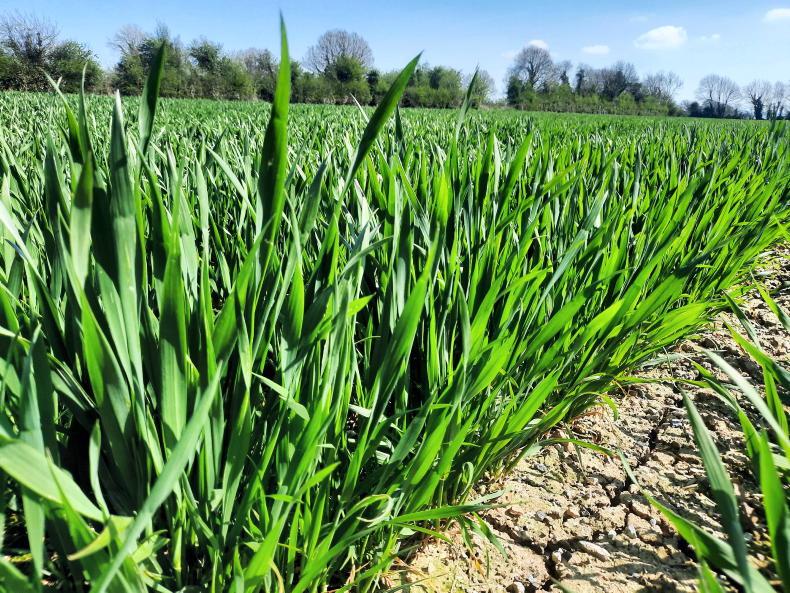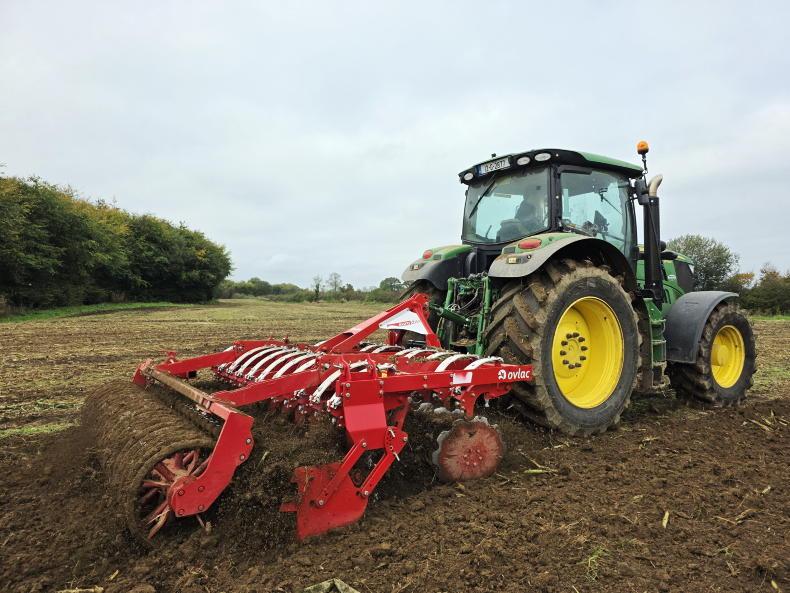It was one of the hottest days of the year walking crops in Tipperary at the end of last week. The Irish Farmers Journal joined Dairygold agronomist Tim McCarthy for the day to see what shape crops were in and what was on the agenda for the coming days.
Tim is based in Cahir, but advises on crops across Co Tipperary and into Cork.
He was grateful for the fine weather of the past few weeks, noting that crops were in great condition and have potential to yield very well.
He wasn’t asking for rain, but noted that it would be helpful for crops.
Farmers were in good form and had time to talk with one commenting that in the same week last year they were under pressure planting their spring crops. This year is very different.
Winter wheat was one of the priority crops of the day.
There is variety in crop growth stages at present, with plenty of variation in sowing dates.
Some crops will receive their T1 fungicide this week, while later sown crops were receiving T0s last weekend.
The first thing to say is crops were clean. There was no rust in any wheat that we saw.
There was some Septoria in the base of crops of Champion and Graham.
Growth regulator in the form of CeCeCe had already been applied.
Leaf 3 was well down the plant and with colder weather on the way it is a while off emergence, so a T0 of sulphur was recommended.
With some rain on the way this was seen as a prudent step.
Tim is deciding on T1 chemistry on a crop-by-crop basis.

Knotgrass in spring barley.
One crop of Champion had some Septoria in the base and leaf 3 was about one-third of the way out. Crops will likely be treated with Peacoq and Pontoon or Revystar, along with Folpet and Medax Max. He will pay the crop another visit ahead of spraying to assess disease pressure after the week’s weather.
Where a T0 has been applied it may help to reduce pressure so this will be another consideration when deciding on what chemistry to apply.
Winter oats were really spotless. Sitting at GS32 the crop of Husky that we saw had already received a herbicide along with CeCeCe and manganese in the form of Actyvium Green.
Tim explained that he likes this manganese product, as it has enough nutrient to cover a deficiency along with some nitrogen, magnesium and sulphur. The manganese is chelated, making it easy to absorb for the plant.

Spring barley was flying last week in the sunshine.
Next up for the winter oats and being applied to the crop last weekend was fungicide Boogie and growth regulator (Scitec which is trinexapac-ethyl or Moddus). Trace elements are being added where needed. Tim said in general winter oats were up to date at the end of last week and added that some nitrogen may still be sitting on the ground waiting to be washed in with the rain.
Up next on our travels was a very forward crop of winter rye. The variety was Tayo and the flag leaf was emerging. It was receiving Medax Max last Friday at 0.35kg/ha for its final growth regulator. It had already received Scitec. The crop was disease free and will get its main fungicide in the coming weeks.
In general winter barley is in a three-spray fungicide programme in Tim’s area. Tipperary has long been associated with winter barley and good yields. With the Galtees to one side, the Knockmealdown Mountains in the middle and Slievenamon to the other side a unique climate is created.

This Graham winter wheat was getting a |T0 of sulphur last week at 3l/ha.
“When you’re growing high-yielding winter crops the key is to look after them and protect them. I got the opportunity to get in pretty early with the T1s this year – late tillering, early growth stage 30 - and tried to get them covered fairly early and keep them clean,” he said.
He added that it is essential to have crops protected early as weather can change and disease pressure can increase very quickly.

This Champion winter wheat had leaf 3 one-third emerged at the end of last week and may receive its T1 this weekend.
At T1 most winter barley crops received Innox Pro and Comet.
Tim commented that crops needed to be minded through the many nights of frost, because of this some crops received a growth regulator with the T1 and some didn’t if conditions were too cold.
As a result, some crops are receiving a strong growth regulator with the T2 fungicide. Some will receive a Trinexapac based product like Medax Max, while those that need a stronger hit might receive Terpal.
Spring barley was thriving. Tim was keen to hold off on herbicides until this week, when a flush of weeds might come after the rain. He expects farmers to be applying herbicides, weather permitting over this weekend.
“Crops are predominantly two to three leaves at this stage. There’s a lot of fertiliser sitting on the ground, waiting for a drop of rain to take it in, but I think after that rain it will really push on crops and they will fairly quickly be ready to do weeds,” he said.

Spring beans were well established and weed free in Tipperary. (small pic, maybe a circle?
Tim has noticed some slug damage following brassica winter cover crops, but it is not a major concern. Crops should pull away once growth comes with the rain next week.
Spring oats are also looking a picture, while beans were well up in the fields that we visited.
“There are unreal seedbeds out there. Everything is perfect really.
“We just got super sowing conditions and it really shows in the crops now as they’re coming up,” Tim commented.

Spring oats. Small pic, can be cropped, maybe into a circle to just show the crop.
It was one of the hottest days of the year walking crops in Tipperary at the end of last week. The Irish Farmers Journal joined Dairygold agronomist Tim McCarthy for the day to see what shape crops were in and what was on the agenda for the coming days.
Tim is based in Cahir, but advises on crops across Co Tipperary and into Cork.
He was grateful for the fine weather of the past few weeks, noting that crops were in great condition and have potential to yield very well.
He wasn’t asking for rain, but noted that it would be helpful for crops.
Farmers were in good form and had time to talk with one commenting that in the same week last year they were under pressure planting their spring crops. This year is very different.
Winter wheat was one of the priority crops of the day.
There is variety in crop growth stages at present, with plenty of variation in sowing dates.
Some crops will receive their T1 fungicide this week, while later sown crops were receiving T0s last weekend.
The first thing to say is crops were clean. There was no rust in any wheat that we saw.
There was some Septoria in the base of crops of Champion and Graham.
Growth regulator in the form of CeCeCe had already been applied.
Leaf 3 was well down the plant and with colder weather on the way it is a while off emergence, so a T0 of sulphur was recommended.
With some rain on the way this was seen as a prudent step.
Tim is deciding on T1 chemistry on a crop-by-crop basis.

Knotgrass in spring barley.
One crop of Champion had some Septoria in the base and leaf 3 was about one-third of the way out. Crops will likely be treated with Peacoq and Pontoon or Revystar, along with Folpet and Medax Max. He will pay the crop another visit ahead of spraying to assess disease pressure after the week’s weather.
Where a T0 has been applied it may help to reduce pressure so this will be another consideration when deciding on what chemistry to apply.
Winter oats were really spotless. Sitting at GS32 the crop of Husky that we saw had already received a herbicide along with CeCeCe and manganese in the form of Actyvium Green.
Tim explained that he likes this manganese product, as it has enough nutrient to cover a deficiency along with some nitrogen, magnesium and sulphur. The manganese is chelated, making it easy to absorb for the plant.

Spring barley was flying last week in the sunshine.
Next up for the winter oats and being applied to the crop last weekend was fungicide Boogie and growth regulator (Scitec which is trinexapac-ethyl or Moddus). Trace elements are being added where needed. Tim said in general winter oats were up to date at the end of last week and added that some nitrogen may still be sitting on the ground waiting to be washed in with the rain.
Up next on our travels was a very forward crop of winter rye. The variety was Tayo and the flag leaf was emerging. It was receiving Medax Max last Friday at 0.35kg/ha for its final growth regulator. It had already received Scitec. The crop was disease free and will get its main fungicide in the coming weeks.
In general winter barley is in a three-spray fungicide programme in Tim’s area. Tipperary has long been associated with winter barley and good yields. With the Galtees to one side, the Knockmealdown Mountains in the middle and Slievenamon to the other side a unique climate is created.

This Graham winter wheat was getting a |T0 of sulphur last week at 3l/ha.
“When you’re growing high-yielding winter crops the key is to look after them and protect them. I got the opportunity to get in pretty early with the T1s this year – late tillering, early growth stage 30 - and tried to get them covered fairly early and keep them clean,” he said.
He added that it is essential to have crops protected early as weather can change and disease pressure can increase very quickly.

This Champion winter wheat had leaf 3 one-third emerged at the end of last week and may receive its T1 this weekend.
At T1 most winter barley crops received Innox Pro and Comet.
Tim commented that crops needed to be minded through the many nights of frost, because of this some crops received a growth regulator with the T1 and some didn’t if conditions were too cold.
As a result, some crops are receiving a strong growth regulator with the T2 fungicide. Some will receive a Trinexapac based product like Medax Max, while those that need a stronger hit might receive Terpal.
Spring barley was thriving. Tim was keen to hold off on herbicides until this week, when a flush of weeds might come after the rain. He expects farmers to be applying herbicides, weather permitting over this weekend.
“Crops are predominantly two to three leaves at this stage. There’s a lot of fertiliser sitting on the ground, waiting for a drop of rain to take it in, but I think after that rain it will really push on crops and they will fairly quickly be ready to do weeds,” he said.

Spring beans were well established and weed free in Tipperary. (small pic, maybe a circle?
Tim has noticed some slug damage following brassica winter cover crops, but it is not a major concern. Crops should pull away once growth comes with the rain next week.
Spring oats are also looking a picture, while beans were well up in the fields that we visited.
“There are unreal seedbeds out there. Everything is perfect really.
“We just got super sowing conditions and it really shows in the crops now as they’re coming up,” Tim commented.

Spring oats. Small pic, can be cropped, maybe into a circle to just show the crop.















SHARING OPTIONS